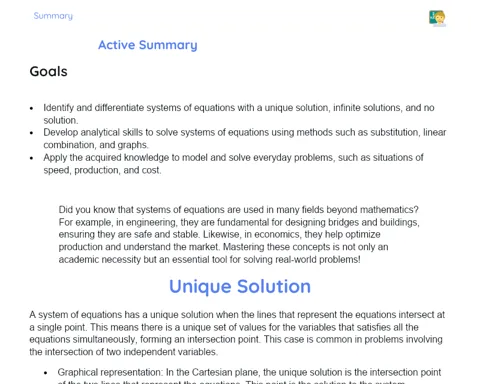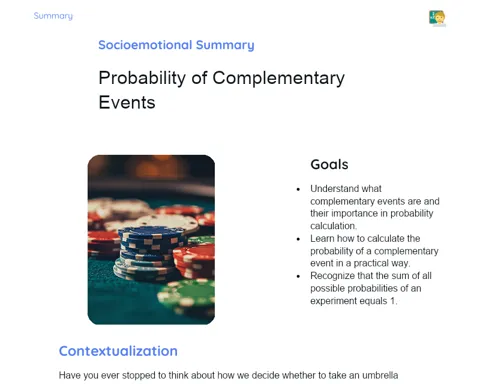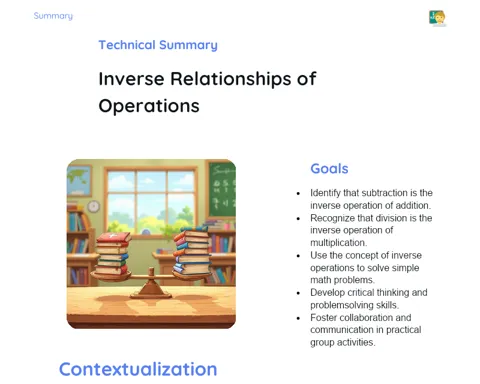Spatial Geometry: Metric Relations of Cones | Socioemotional Summary
Objectives
1. Understand the main metric relationships in a cone, including how to calculate the height and the slant height from the height and the radius of the cone.
2. Develop self-awareness skills by recognizing and understanding your own emotions when facing mathematical challenges.
3. Encourage responsible decision-making when solving spatial geometry problems, reflecting on the best approaches and strategies.
Contextualization
Did you know that the geometry of a cone is essential for creating common objects, such as funnels and party hats? By exploring the metric relationships of cones, you not only enhance your mathematical skills but also develop important emotional competencies to face challenges with confidence and clarity. Let's discover together the fascinating world of cones and how it connects to our daily lives! 🚀📐
Important Topics
Definition of Cone
A cone is a geometric solid that has a circular base and a lateral surface that narrows to a point called the vertex. It is a common shape both in nature and in man-made objects, being essential in the study of spatial geometry.
-
Circular Base: The base of the cone is a perfect circle, which defines the width of the cone.
-
Lateral Surface: The lateral surface extends from the base to the vertex, forming a straight line along the slant height.
-
Vertex: The top point where all lines of the lateral surface meet.
Elements of a Cone
The main elements of a cone are the height, the radius, and the slant height. These elements are fundamental for calculating all metric relationships in the cone and understanding its properties.
-
Height (h): The perpendicular distance from the vertex to the base of the cone. It is a crucial element in determining the volume and surface area of the cone.
-
Radius (r): The radius of the cone's circular base. It defines the width of the base and is essential for calculating the area of the base.
-
Slant Height (g): The slant height is the line segment that connects the vertex to any point on the circumference of the base. It is important for calculating the lateral area of the cone.
Metric Relationships
Metric relationships are mathematical formulas that help us calculate different dimensions of a cone from its main elements. The most important ones include the application of the Pythagorean Theorem, the formulas for base and lateral area, and the calculation of the volume of the cone.
-
Pythagorean Theorem: Used to find the slant height (g) from the height (h) and the radius (r). Formula: g² = h² + r².
-
Base Area (A_b): Calculated using the formula A_b = πr², where r is the radius of the base.
-
Lateral Area (A_l): Calculated using the formula A_l = πrg, where g is the slant height.
-
Total Area (A_t): The sum of the base area and the lateral area, calculated by the formula A_t = A_b + A_l = πr² + πrg.
-
Volume (V): Calculated using the formula V = (1/3)πr²h, where r is the radius of the base and h is the height.
Key Terms
-
Cone: A geometric solid with a circular base and lateral surface that narrows to the vertex.
-
Height (h): Vertical distance from the vertex to the base of the cone.
-
Radius (r): Radius of the cone's circular base.
-
Slant Height (g): Line segment that connects the vertex to any point on the circumference of the base.
-
Pythagorean Theorem: Formula to relate the slant height, height, and radius of the cone.
-
Base Area: Area of the circle that forms the base of the cone.
-
Lateral Area: Area of the lateral surface of the cone.
-
Total Area: Sum of the base area and the lateral area of the cone.
-
Volume: Three-dimensional space occupied by the cone.
To Reflect
-
How did you feel while calculating the different dimensions of the cone? Were you able to maintain calm and focus?
-
What strategies did you use to deal with frustration or anxiety when facing mathematical difficulties? Were they effective?
-
How can you apply the emotional regulation skills learned in this lesson to other areas of your academic and personal life?
Important Conclusions
-
Understanding the metric relationships in a cone allows us to apply important mathematical formulas such as the Pythagorean Theorem, area, and volume calculations.
-
Recognizing and naming our emotions while facing mathematical challenges is crucial for our personal and academic development.
-
The ability to make responsible decisions when solving complex problems is a valuable skill not only in mathematics but in various areas of life.
Impact on Society
The geometry of cones is not just theoretical; it has practical applications that directly affect our daily lives. For example, the design and production of funnels, party hats, and even traffic cones depend on this knowledge of metric relationships. Understanding how to calculate different dimensions of the cone can help us solve real-world problems efficiently and creatively.
Emotionally, learning to deal with frustrations and anxieties when solving mathematical problems can make us more resilient and better prepared to face various challenges. By developing self-awareness and emotional regulation strategies, we can improve our academic performance and our ability to navigate interpersonal relationships in a more balanced and healthy way.
Dealing with Emotions
To apply the RULER method at home, I propose that you do some self-reflection after studying the topic of cone geometry. First, acknowledge the emotions you felt during the study. Understand what caused these emotions and their impacts. Name these emotions accurately and express them in a journal or in a conversation with a friend or family member. Finally, practice emotional regulation techniques, such as deep breathing, to better manage these emotions. This exercise will help improve your self-control and confidence when facing future challenges.
Study Tips
-
Create diagrams and visual sketches of cones to help visualize the metric relationships. Use different colors for elements like height, radius, and slant height.
-
Practice solving cone geometry problems using real-life examples, such as calculating the dimensions of an ice cream cone.
-
Form study groups to discuss and solve problems together, sharing strategies and techniques that help in solving complex questions.



